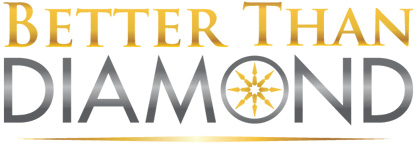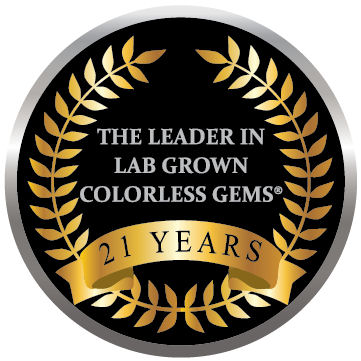- Home
- Asha Diamond Simulants
- Asha® Education : Hearts & Arrows Cut
Categories
- Amora Gem
- Takara Lab Grown Diamonds
- Overnight Earrings
- Asha® Diamond Simulant
- Rings
- Earrings
- Bands
- Forever Brilliant Moissanite - Certified
- Moissanite
- Asha® Dangle Earrings
- Asha® Stud Earrings
- Pendants
- Avarra Lab Grown Rubies
- Avarra Lab Grown Alexandrite
- Avarra Lab Grown Colombian Emeralds
- Avarra Lab Grown Sapphire
- Amethyst (Natural Bolivian)
- Miscellaneous
Popular Brands
Our Newsletter
Asha® Education : Hearts & Arrows Cut
Asha® Hearts & Arrows Cut
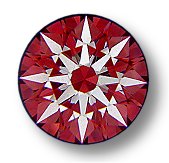
Asha® Hearts and Arrows
under the scope
Our latest generation of Asha® is being cut to the exacting standards of the Hearts and Arrows cut, something fewer than 1 in 1000 (thats less than .1%) round cut diamonds will ever achieve! This article is designed to help you understand the difference between a typical round cut stone, and a Hearts and Arrows round.
Hearts and Arrows is an industry term for a specific type of round cutwhere all facets are in perfect alignment, proportion and symmetry. Cut is one of the four major components of diamond grading. Cut controls 98% of the brilliance of a round cut gem or diamond. However, cut is often the least understood of the four C's, and often the most disregarded. It's easy to understand carat weight, color and clarity, but cut is difficult.
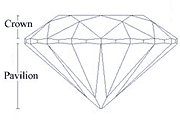 The top half of a round diamond is called the 'crown'. It is the crown that dictates the amount of fire of a round cut gem (how much light is broken into its spectral colors). The bottom half of a round cut is termed the 'pavilion'. The bottom half controls how much light that enters the diamond is returned back to the viewer - this is termed its brilliance.
The top half of a round diamond is called the 'crown'. It is the crown that dictates the amount of fire of a round cut gem (how much light is broken into its spectral colors). The bottom half of a round cut is termed the 'pavilion'. The bottom half controls how much light that enters the diamond is returned back to the viewer - this is termed its brilliance.
How the facets on both the top and bottom half of the round cut gem line up (symmetry) determines the scintillation of a gemstone, or the way it plays with light as it reflects it to the viewer.The interplay of all of these facets on both the top and bottom half of the diamond or diamond simulant control how much light that enters a the stone is returned back to the viewer. The inside of a diamond can be represented as a hall of mirrors. The more precisely aligned and shaped the mirrors, the more light will be reflected back out rather than lost as it bounces between mirrors.
In a typical diamond, roughly 68% of the light that enters ends up being reflected back to the viewer.By contrast, in a hearts and arrows diamond, 96-98% of all light that enters is reflected back out!
This is a result of a painstaking effort on the part of the cutter to ensure that all facets (mirrors) are perfectly symmetrical, in perfect alignment and perfectly proportioned. It is very easy to see the difference in diamond when comparing a typical round diamond to a hearts and arrows diamond.
The difference is simply a much more brilliant stone!
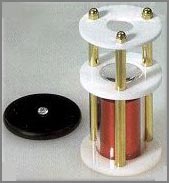
In order to view how light is being reflected within a stone, various viewers are used that magnify your view of the gem, and tint the light so that the eye view how the light is being reflected. They do under various names depending on what jewelry store you visit, but most high end jewelry stores will have one.
They look like this (The image on the right).
Hears and Arrows Scope➜
When viewed with the tinted light, patterns will show up on the stone. A typical round gem will show a whirl pattern, with no real symmetry. What this shows is that the facets are not in proper alignment, resulting in a blurred out look as the light bounces around and is leaked out rather than being reflected back to the viewer.
By contrast, the top of a hearts and arrows gem will show a perfect crisp arrows pattern, visually indicating that all the facets are in alignment, and that the light return has been maximized by the cutter.
In similar fashion, you can view the bottom of the Hearts and Arrows gem and see the following pattern (on the right):
 Arrows - Crown
Arrows - Crown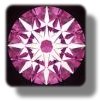
Again, the crisp pattern shows that the bottom half of the stone's facets are also in perfect proportion and symmetry. Any misalignment of any facet will result in arrows that bend at the tips, or hearts that are uneven or other blurring out of what should be a perfect, crisp pattern.
So why aren't all round diamonds cut to Hearts and Arrows? The reason is simple: time and money.
A typical round cut diamond can be finished in roughly 2 hours. By contrast, a Hearts and Arrows diamond can take anywhere from 8 hours to several days, and even then may not show the perfect symmetry required to produce the crisp Hearts and Arrows pattern. The more cutting time involved, the more the cutter has to charge for his/her time. While cutting an Asha® is simpler than diamond because you have a flawless rough to work with, our cutters have to spend on average 8x as long for the Asha® H&A simulant vs. if they simply wanted to cut a standard round brilliant.
Additionally, in the diamond world, diamonds are often cut to achieve a certain size. Most retail customers are very focused on the size of a diamond -i.e. they want a 1 ct. A diamond achieves a heart and arrows cut by cutting away a lot of original rough. Thus, diamond rough that could be cut into an average round 1 ct. may only amount to a .70 Hearts and Arrows cut. Thus, most cutters will opt to please the typical consumer who is interested in a specific size diamond, and additionally, many cutters do not have the skill necessary or the funding to produce something as rare as a Hearts and Arrows cut.
